At the end of the first millennium, Slavic and Finnish tribes began to use footcloths - special rectangular cloths for wrapping legs. This item of clothing was very effective at that time, as a result of which it began to be used in the armies of many countries. In the Russian Armed Forces, foot wraps were specially attached to high and heavy tarpaulin boots.
These shoes were very uncomfortable, and at the beginning of their service, every Russian recruit was interested in how to wrap foot wraps and how to get used to new shoes. This will be discussed in the article.
Where do foot wraps go?
In the Old Russian language, the words “port” and “footcloth” mean a piece of fabric, part of a canvas for wrapping a leg. In this regard, in many countries the word “footcloth” is associated with Russia.
A feature of traditional army shoes is the difficulty of wearing them with a sock: when interacting with rough shoe material, it quickly breaks. In addition, socks can get confused and crumple, rubbing your feet. Wearing army boots with foot wraps is much more comfortable: if the boot is larger than your leg, you can fill the free space with this piece of fabric. This result can be achieved provided that you have theoretical knowledge of how to wind foot wraps. Those for whom they are an ordinary thing do not see anything complicated in this process.
Features of foot wraps
A footcloth is a piece of durable rectangular fabric that is used to wrap the legs. The product has the same functionality as a sock and is worn with boots. The fabric for foot wraps is selected according to the time of year. For the winter period they are made from the following types of fabric:
- wool;
- bike;
- flannel.
During cold weather, footcloths made from 50% wool and 50% cotton are in demand. In summer, a cotton or cloth product is used.
It is believed that the standard size of foot wraps is 35 x 90 cm. However, this is not entirely true. Over time, the recommended product size has changed:
- since 1978, foot wraps have been made in sizes 35 x 90 cm;
- since 1983, the parameters of the finished half-pair were 50 x 75 cm;
- since 1990, the width of the product has become 15 cm smaller. The finished footcloth measured 35 x 75 cm;
- Today, according to the army regulations, the parameters of a half-pair are 45 x 90 cm.
There are also other sizes of finished footcloths. You can make it yourself by individually selecting the dimensions. To do this, a piece of the selected fabric is cut into 2 parts so that the length of the finished product allows you to wrap the foot twice.
In some situations, such products will be better than socks. Their advantages:
- dry quickly;
- easy to wash;
- do not wear out for a long time;
- self-production is possible;
- you can wear larger shoes;
- reduce sweating of the skin;
- retain heat well.
Foot wraps in hiking conditions help maintain the health of the skin - they do not allow fungal diseases to develop. The disadvantages of the product include:
- reduction in shoeing speed;
- difficulty putting on;
- inability to wear without shoes.
If you put the product on carelessly, abrasions, painful blisters, and skin irritation may occur.
This item is used not only by the military, but also by people who have to live in difficult climatic conditions. Foot wraps are widely used by fishermen, hunters, and rangers.
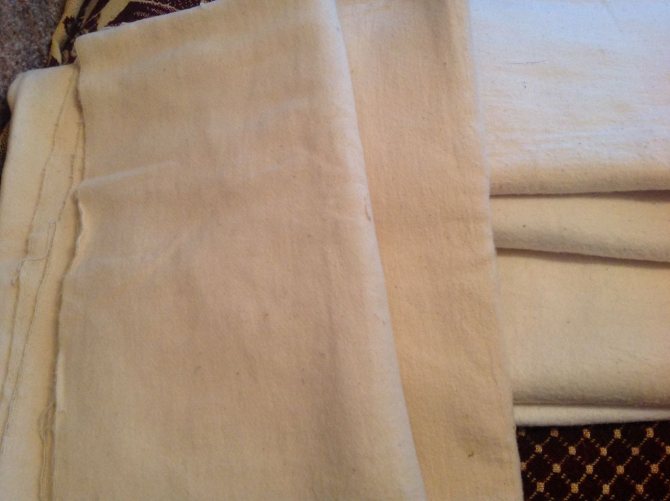
Flannelette
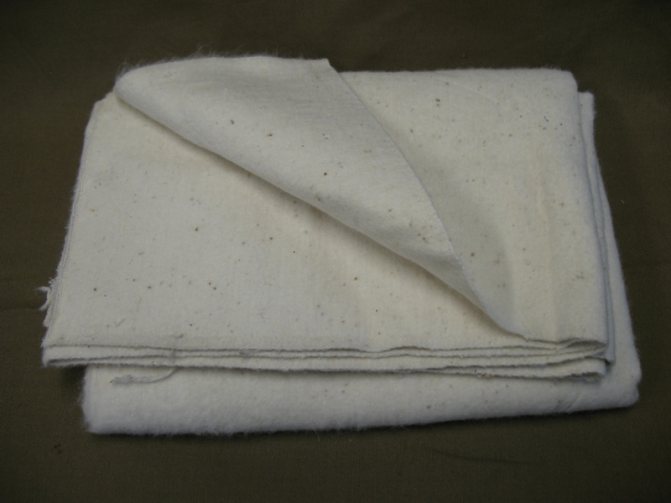
Flannel
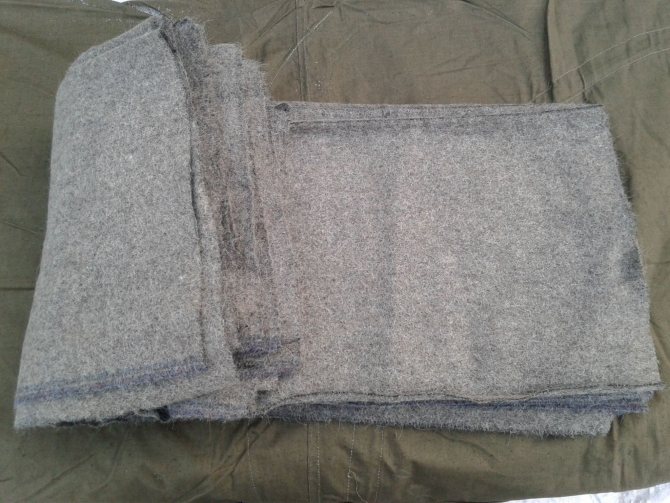
Woolen
Benefits of foot wraps
Compared to socks, foot wraps have the following advantages:
- They are easy to wash because you don't have to match pairs and sizes like socks. They dry quickly. Boiling and other types of washing can be applied to them.
- Foot wraps are less susceptible to wear and tear.
- If the footcloth gets wet, you can use its dry edge. According to reviews, even when wet it is much better than a wet sock.
- If necessary, it is easy to make a footcloth yourself. Any piece of fabric of the appropriate size will be suitable for it.
- Foot wraps retain heat well.
Disadvantages of foot wraps
- Compared to a sock, putting on a foot wrap is much more difficult.
- The process of putting on shoes is much longer. According to the rules established in the Soviet Army, soldiers were required to learn how to wrap foot wraps in twenty seconds.
- Carelessness when wrapping can lead to abrasion and serious irritation of the skin of the legs. To avoid this, you need to know how to wrap footcloths correctly.
- It is impossible to wear outside shoes like a sock, the foot wraps unwind and the foot remains bare;
On the relevance of the issue
A set of footwear consisting of boots and foot wraps was previously used in the armies of many countries, but in the 20th century almost all of them switched to a set of high-top boots and socks.
Foot wraps were abandoned in the armies of the GDR (in 1968), Finland (in 1990), and Ukraine (in 2004). In the Russian Armed Forces, foot wraps were used for several centuries until the 2010s, when tarpaulin boots were replaced by ankle boots as the main soldier's footwear.
Nowadays, foot wraps are already something outdated and are almost never used. But those who have had to dry wet socks over a fire while on a camping trip know that in some cases foot wraps are a very necessary thing. Often, when drying over a fire, wet socks become unusable. A T-shirt or undershirt torn into two pieces can help out of such a situation.
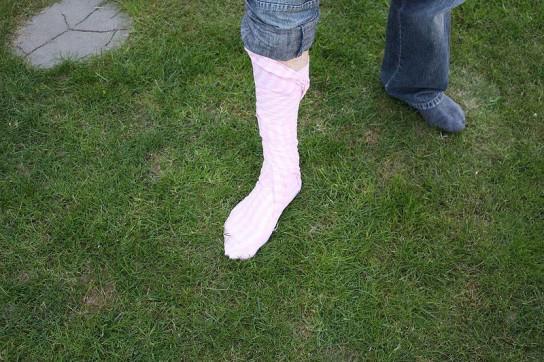
Tourists who have not served in the army often have to face the question: how to wrap foot wraps?
Instructions compiled by specialists will allow you to deal with this easily and quickly.
History of foot wraps
Foot wraps have been associated exclusively with the army since ancient times. They take their history back to Ancient Rome, where they were used by Roman soldiers. For many, foot wraps are associated exclusively with Russia. Judging by many sources, Peter the Great brought them. Indeed, foot wraps are an ancient element. They were used both when wearing boots and when shoes were bast shoes.
After the end of the Great Patriotic War, foot wraps were adopted for everyday use in all countries of the USSR and today they have begun to give way to socks, primarily due to the replacement of footwear for personnel.
Preparatory stage
Before wrapping foot wraps, it is recommended to first carry out the following preparation:
- Inspect your feet. This will allow you to identify places where abrasions may appear.
- Wash your feet. It is advisable to use cold water for this.
- Wipe them dry.
- Trim your toenails. In order to prevent the occurrence of severe pain when walking, it is undesirable to cut them very short, as this may lead to them growing into the flesh of the fingers.
Useful tips
To wear foot wraps for a long time without rubbing your feet, you need to consider the following recommendations:
- The fabric should be wound tightly, the material should not dangle.
- It is recommended to wind the fabric from the toe to the shin. This will prevent it from getting knocked down when walking.
- If your feet get wet, you can wrap them with the dry end that was previously on the boot.
- Do not sew or overcast the edges of the product, this will lead to rapid chafing and the formation of calluses.
- There is no need to allow creases or folds to avoid chafing the skin while moving.
- If foot wraps are worn in the summer, it is important to put insoles in the shoes.
- A new product must be washed before wearing, this will soften the fabric.
Before wrapping the footcloths, you should inspect your feet for chafing. Wash them with cool water and wipe dry. Cold water will help tighten the pores to prevent dust and dirt from clogging them.
Knowing how to properly wind foot wraps, you can walk a long distance without feeling discomfort in the foot area. This is a convenient product that prevents your feet from sweating and freezing, while being as inexpensive as possible.
Performance
The procedure is carried out in several stages:
- Before wrapping footcloths, you need to spread the material on a clean and flat surface. This condition is for those who have no experience in winding foot wraps. Anyone who knows how to perform this procedure by weight must straighten and stretch the material in their hands.
- Place your foot on the fabric so that it is located at the right edge at a distance of 200 mm. At the same time, it is not recommended to touch the edges of the footcloth with your toes.
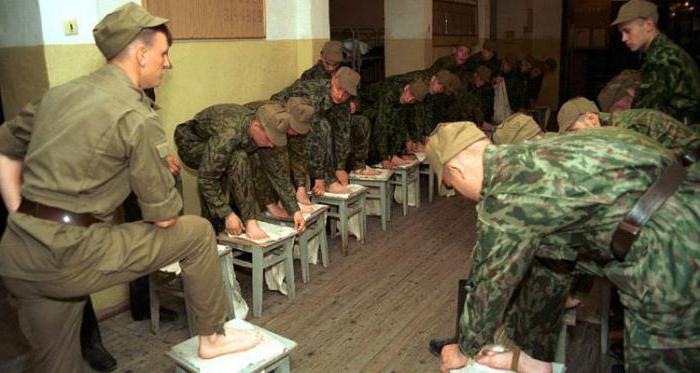
- Cover the leg with the resulting small corner of the material. It is advisable that folds do not form.
- Press down the corner with the sole. To prevent the footcloth from crumpling there, you need to straighten it, pulling it a little with your left hand.
- After the toes are covered, the edge of the footcloth should be smoothed
- The remaining large piece of fabric is used to wind the second layer. They need to cover the first layer without changing hands. The second layer should be wrapped around the foot, sole and heel.
- The free edge of the footcloth is wrapped around the lower leg. This can be done by pulling it up the leg.
- You can adjust the tightness by pulling the footcloth over the edge.
- The remaining end of the footcloth after wrapping the leg with the second layer should cover the shin in its lower part. As a result, the front edge of the footcloth is covered and the heel is wrapped.
- Tie the footcloth so that it does not slip off.
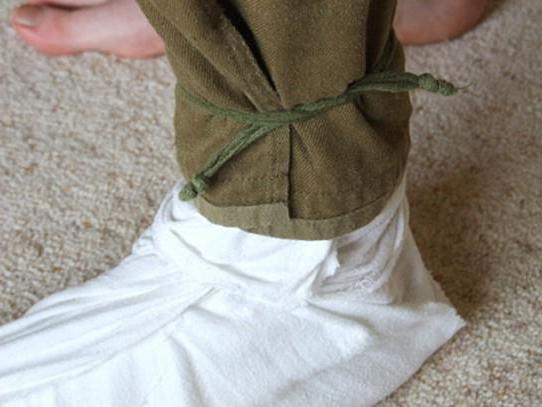
- Pull down the trouser leg over the foot wraps.
- Put on your boots.
Winding methods
It is important to know how to wrap footcloths correctly to prevent chafing of the skin. A skillfully worn product will protect your feet from the cold and will not roll down in boots, as happens with ordinary socks.
Instructions for properly winding footcloths.
- Spread the product on a flat surface.
- Place your foot obliquely to the edge of the fabric - the heel should look at the bottom corner, the toe should be on the opposite side of the top corner in an unfolded position, the foot retreats from the edge of the product by 20 cm.
- Wrap the corner around your foot.
- Fold the corner under the sole.
- Wrap the long edge of the product around the foot, gradually moving upward, while simultaneously eliminating the folds.
- After wrapping the foot wrap around your foot, wrap the remaining edge around your shin and tuck in the tip.
It is recommended that when wrapping your right leg, you take the footcloth, namely its outer corner, with your right hand, and on your left leg with your left hand.
Products should fit tightly around the legs, be wound moderately tightly, and not have folds.
The second method is called "lazy". The fabric is placed on the top of the boot, and the foot is inserted into the shoe at the same time as the product. This is a quick method that does not allow you to walk for a long time. In practice, it will last and will not cause skin chafing for 2-3 hours, subject to low physical activity. Usually used when there is no time for full winding.

What nuances should be taken into account?
- Foot wraps should be wound tightly. Otherwise, the appearance of painful blisters is guaranteed. Often in the army, in order to avoid heavy physical exercise, some soldiers deliberately wound their footcloths loosely.
- If the winding is done inward, the footcloth may become knocked down when walking. Therefore, the winding procedure must be performed starting from the toe outward.
- If the footcloth is fastened correctly on the leg, it will retain heat better and will not allow moisture to pass through. If your feet are very wet, it is recommended to use the dry end of a footcloth to wrap around your foot. After some time, the wet side of the fabric will dry and it will also be usable. Thus, when your feet get wet, there is no need to change foot wraps.
- Foot wraps are not recommended to be sewn or overcast. The presence of unnecessary parts on the fabric can lead to chafing and irritation of the skin of the legs.
- If the footcloth on your foot is frayed, you can use it by wrapping the other side around your foot.
- When wrapping, it is recommended to ensure that no rough folds, creases or scars are formed, since they can cause severe rubbing on the legs when walking.
- If foot wraps are used in the summer, it is necessary that each pair has an insole.
- If the shoes are too big, the footcloths may slide down. They will remain in place if the fabric fits tightly to the tarpaulin boot. This can be achieved by choosing a larger piece of material under the footcloth.
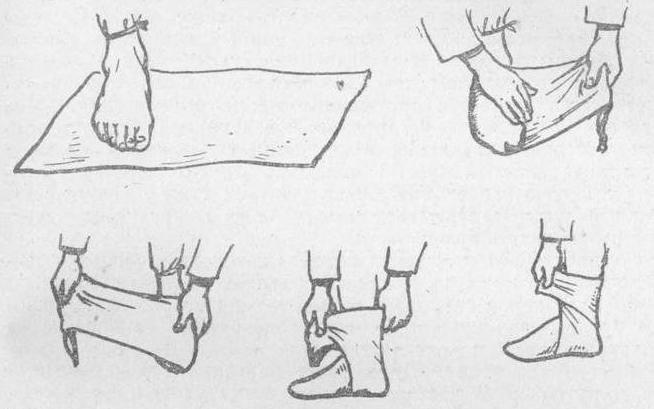
Rules for winding footcloths
A properly wound footcloth is the key to convenience. If this is not done as it should be, then you can get a lot of inconvenience and problems. If wound incorrectly, the footcloth will constantly slip, which greatly interferes with fast and comfortable movement. Therefore, it is so important to do it correctly, following the rules.
It is believed that winding foot wraps is an entire art that you learn only over time. First of all, this is the size of the foot wraps. It must comply with the standards.
The first thing you need to pay attention to is the size of the foot wraps. It must comply with the rules. The leg should be examined for wounds and damage. Also, it should not be wet, but must be clean and dry to prevent the penetration of dirt. In summer, you should use a liner.
The footcloth is placed on a level place or pulled evenly by hand (if the winding is done by weight). The foot is placed closer to the right edge, after which the front top is used to wrap the foot from above, while simultaneously smoothing out the resulting folds. The corner itself is pushed under the sole and remains in this position with the help of the free end, which is pulled with the other hand. After this, carefully straighten all the folds that appear and wrap the foot and sole in a full turn.
The most important thing when wrapping a footcloth is not to leave any folds. After all, they are the cause of abrasions and calluses on the feet.
The footcloth, of course, has a large number of advantages over socks, which have recently been crowding it out of the lives of soldiers. We can say that her era is coming to an end.
In this article, we found out what size foot wraps meet the requirements and how to wear them correctly.
At the end of the first millennium, Slavic and Finnish tribes began to use footcloths - special rectangular cloths for wrapping legs. This item of clothing was very effective at that time, as a result of which it began to be used in the armies of many countries. In the Russian Armed Forces, foot wraps were specially attached to high and heavy tarpaulin boots.
These shoes were very uncomfortable, and at the beginning of their service, every Russian recruit was interested in how to wrap foot wraps and how to get used to new shoes. This will be discussed in the article.
Advantages of foot wraps
The advantages of foot wraps include their durability and ease of use. In manufacturing, you can use any material that comes to hand. The main thing is that the size of the soldiers' foot wraps meets the standards. The wear of foot wraps is an order of magnitude less than that of socks, because more worn places can be replaced with less worn ones.
Their most obvious advantage is fast drying. Footcloths tend to dry out very quickly. And their most important advantage, which will come in handy when wearing shoes for a long time in hot weather, is versatility. The footcloth can be easily turned over with the wet side outward and the dry side inward. Thanks to this, the skin on the feet is almost always dry. When shoes fall into water, only the top layer gets wet, while the inner layer is still warm, which is especially important in cold climates to preserve the soldier’s health. Another useful property of footcloths is that it fills more space in shoes, which is exclusively beneficial for the feet.
Let us highlight the main advantages of foot wraps:
- durability;
- convenience;
- quick drying;
- do not harm the feet (if used correctly).
Advantages
It is not for nothing that this invention, despite the 21st century, is still held in high esteem - they have many advantages over the highest quality socks.
- Under boots, socks wear out quite quickly, and foot wraps can withstand friction against the rough parts of the boot, so they don’t wear out so quickly.
- It's easy to dry wet foot wraps when unfolded - it won't take as much time as drying socks.
- They are easier to wash for a group - there is no need to sort them into pairs afterwards.
- They can be boiled and treated with bleach.
- If it gets wet, only the outer layer is saturated with moisture - it can be rewound on the go, thus avoiding colds and hypothermia of the feet.
- If any part of the flap is worn down to a hole, the footcloth is rewound in the same way - now injuries from friction are not terrible.
- During a long forced march, properly wound flaps will not slip, but the elastic of the socks does not always hold up.
- In cold weather, a double layer of warm fabric will better protect your feet from the cold, and in summer it will absorb sweat faster, leaving your feet dry.
There are also significant inconveniences - wrapping it up takes time and skill, and when removing the shoes, the foot will remain bare, because leaving it on the foot as a sock will not work.
It might be useful to read:
- Crafts from vegetables (104 photos) - for school and garden;
- What cosmetics are there and what they are for;
- Hair colors for men: types and recommendations for choosing Red hair for men;
- How to give a birthday gift in a fun and original way;
- What an unusual way to give a birthday gift;
- My family is my treasure ;
- Christmas game program for children “Christmas nursery rhymes” Carrying out Christmas for children;
- Poems about Santa Claus;











